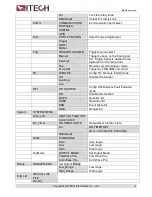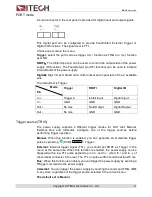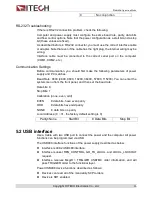
Basic
operation
Copyright © ITECH Electronics Co., Ltd.
21
PORT mode
A 4-pin connector in the rear panel is provided for digital input and output signals.
This digital port can be configured to provide Fault/Inhibit, External Trigger or
Digital I/O functions. The signal level is TTL.
Choose one mode in the menu:
Trigger:
select the port mode as trigger, In(+) function as TRIG pin, In(-) function
as GND
RI/DFI
:
The Inhibit Input pin can be used to control the output state of the power
supply (RI function). The Fault Output pin (DFI function) can be used to indicate
internal faults of the power supply.
Digital
:
Digit I/O port, Read and control output and input state of the 2 available
pins.
The default set is Trigger.
Mode
Pin
Trigger
RI/DFI
Digital I/O
In +
Trigger in
Inhibit Input
Digital Input
In -
GND
GND
GND
Out +
No Use
Fault Output
Digital Output
Out -
No Use
GND
GND
Trigger source (TRIG)
The power supply supports 4 different trigger modes for LIST test. Manual,
External, Bus and Immediat. Configure one of the trigger sources before
performing trigger operation
:
Manual
: When this function is enabled, you can generate an immediate trigger
pulse by pressing
(Shift)+
Enter
(
Trigger
)
External:
External trigger signal (TTL), you should set PORT as Trigger in the
menu at the same time. When this function is enabled, the power supply can be
triggered with a low TTL pulse applied to pin In + and In
– (short In + and In –) of
the terminal connector in the rear. The TTL on pulse width should be at least 5 ms.
Bus:
When this function is enabled, you can trigger the power supply by sending a
TRIgger command to the power supply
Immediat:
You can trigger the power supply by sending the command TRIG: IMM
in any case, regardless of the trigger source selected in the current menu.
The default set is Manual
















































